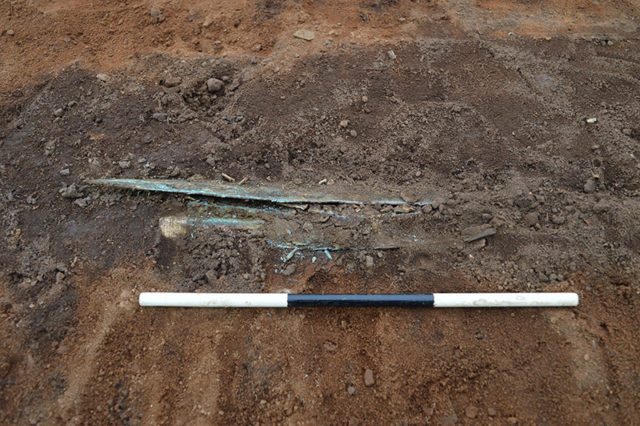Earlier this month on the eastern coast of Scotland, the Council of Angus, Carnoustie was clearing land to build two soccer fields and uncovered pits and post-holes that were signs of ancient buildings. Upon further digging, archaeologists noticed a slight glimmer of gold. To reveal the artifacts in controlled conditions, a 176-pound block of soil around the find was removed and taken to the archaeology firm, GUARD’s, laboratory.
After a week of careful cleaning and dusting away the dirt, a bronze spearhead adorned with gold was uncovered. Also found was a bronze sword with a pommel made of tin and lead, along with its bronze scabbard mount and chape, a small reinforcement at the tip of the scabbard to protect the point of the blade.
The archaeologists also found small pieces of skin from animal pelts that may have lined the scabbard, as well as a leather and wooden sword sheath. As the skin, wood, and leather are made of organic materials, radiocarbon dating can be performed to determine the exact age of the relics.

Tin, a component of bronze, is not native to Scotland but is found in other parts of Great Britain. Gold and copper, another component of bronze, are found in Ireland. As of yet, it is unclear how the metals got to Scotland, but GUARD representatives believe there was a system of trade that existed between the three countries.
Researchers believe the artifacts are about three thousand years old, placing them late in the Bronze Age, which corresponds with the remnants of twelve Bronze Age roundhouses uncovered near the largest Neolithic hall ever found in Scotland. These date back to 4,000 BC and were built on the remains of the hall. The fact that so many were found suggests that a village may be waiting to be revealed as well. If so, it would be the first of its kind to be discovered in Scotland.
The gold and bronze found on the artifacts are indicative of a wealthy warrior society that existed between approximately 1,000 to 800 BC, when Scots began decorating their weapons and tools and producing jewelry, possibly for trading. It also lends credence to Celtic myths that speak of weapons shining brightly in the sun.
Researchers have described this find as extremely rare since organic items do not often last after being buried for so many years. According to Beth Spence, one of the conservators who worked on uncovering the artifacts at the GUARD laboratory excavation, “Organic evidence like Bronze Age wooden scabbards rarely survives, so this just underlines how extraordinary these finds are.”
Alan Hunter Blair, from GUARD, remarked, “Gold decoration was probably added to this bronze spearhead to exalt it both through the material’s rarity and its visual impact.”
“The archaeology uncovered at Carnoustie is undoubtedly of both national and international significance, and will certainly further enhance our knowledge of the prehistory of this area, providing an invaluable opportunity to learn more about how people in Angus lived in the Neolithic and Bronze Age,” said Claire Herbert.

Very few bronze spearheads of this type have been found in excavations in the British Isles. A few have been found in Ireland, one was discovered in England, and one other was uncovered in Scotland in 1963 at Pyotdykes Farm, about twelve miles from Carnoustie, Mail Online reported.
It is unknown why these weapons were bundled and buried together, as no evidence of a grave or ritual was found with them. These types of artifacts are usually found in rivers or streams, possibly deposited there during some type of ritual. Archaeologists believe there are still more treasures to be uncovered at the site, and excavations there will continue. The GUARD team is giving tours of the site and is using locally-purchased tools and materials to keep the money in the area. Their efforts are also providing jobs to residents and giving experience to recent graduates of the Dundee School of Archaeology.
